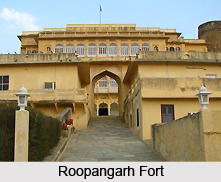 There are several places of interest that lie outside the periphery of the Pushkar city. Rented cars and other means of transportations are available to tour these tourist sites. The excursion tours from Pushkar comprise of: -
There are several places of interest that lie outside the periphery of the Pushkar city. Rented cars and other means of transportations are available to tour these tourist sites. The excursion tours from Pushkar comprise of: -
Ajmer: It is the nearest tourist attraction that lies outside the city boundaries of Pushkar. Local transportations are easily available to arrive at this place. Ajmer is popular for the dargah of Chisti. It is located at a distance of approx 11 kilometers from Pushkar. There are historical sites at Ajmer too that are worth checking out.
Kishangarh: It is located 27 kilometers away from Ajmer. This town is famous for its miniature paintings, more popularly known as Bani Thani. There is fort at Kishangarh that has been converted into a heritage hotel.
Roopangarh Fort: It was built by King Roop Singh of Kishangarh in the year1648. hence it was named after the king. Originally it was built as a nine turreted fort but went through constant renovations and additions. This fort is also accessible from Jaipur.
Kuchaman: This place is well known for its fort. This place will take the travelers back to time. At this place one will come across the Meera Mahal. It depicts the life of Meera Bai through the miniature paintings. There are also Lok Dev temples that belong to Sant Tejaji, Sant Gogaji, Sant Pabu Rathore, Baba Ram Dev, Sant Kesaria Kanwarji, Sant Jamboji, Sant Ravi Das, Sant Kabir, Guru Nanak and Khwaja Moin-ud-din-Chisti. Within this town there are the Meena Bazaar and the China Pol that are worth checking out.
Sambhar Lake: It is famous for the lake. This lake is a safe haven for almost 140 species of birds. Hence bird watchers throng the place to check them out. The name of this lake also figures in the Hindu legends. This wetland is internationally famous.
Tilonia: It is a small village that has been successfully converted into a cooperative industry. It is one of the major centers around Pushkar that is known for leather handicrafts.
Foy Sagar: This artificial lake is located at a distance of 5 kilometers from the city of Pushkar. This lake was named after the engineer who created it. The picturesque beauty of the lake attracts tourists to this place.
Merta: It is located at a distance of 63 kilometers west from Pushkar. It is primarily hailed as the birthplace of Meera Bai. The city was founded by Rao Duda, the fourth son of the Marwar ruler Rao Jodha in 1488. At the outskirts of the town the travelers will come across the Charbhujanath Temple. This very place is now famous for Malkot Fort. Besides this fort there is also Dudagarh. Though it is not as big as the other one yet it is worth a visit. The places of interest in and around Merta comprise also of Palace of Meera and Shahi Jama Masjid.



















